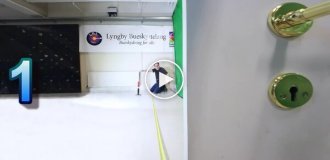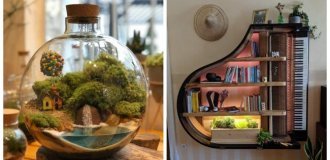German designer Klaus Lute and his outstanding cars (9 photos)
The love for German cars in Russia developed back in the 90s, and if you were born later, you still understand why. These cars in many ways became the personification of that era, an integral part of it and one of the most vivid memories of contemporaries.
Despite the fact that everyone knows them by sight, only devoted fans know who created this “face”.

And today's story is about Klaus Lüth, the creator of the most recognizable BMW models.
Klaus was born in 1932 into the family of a carpenter in the German city of Wuppertal. The family was large - Klaus was the second child of five. The war took his father away from the family in 1945, our hero was going to follow in the footsteps of his older brother and become an architect, but at the age of 16 he got a job as an apprentice in a workshop that made automobile bodies and never thought about architecture anymore. There he studied for 6 years and worked on bodies for buses, and in 1954 he received an official job at the German company Neckar, which produced Fiat under Italian license. There Klaus helped older and experienced comrades in developing the exterior.
Neckar was a subsidiary of another German brand, NSU. Quite quickly, the capable young specialist was noticed at the head office and invited to work on the design of cars of his own design. And he came there during the brightest period of the existence of this little-known automaker in Russia.

NSU Spider
His first work in 1960 was the youngest in the NSU model line, Prinz 4, which definitely has similarities with our Zaporozhets. And the design is approximately the same: rear-engine, two-cylinder, air-cooled, but it has no relationship with the ZAZ; it appeared later. But it is known that the designers were influenced by another rear-engine car - the American Chevrolet Corvair. His second work was significant for the entire brand. The NSU Spider model became the world's first production car with a rotary piston engine, the use of which subsequently made the brand famous.

NSU Ro 80
Prosperity in post-war Germany gradually began to improve, and the NSU leadership decided to take aim at the middle class. Claiming to be revolutionaries, it was fundamentally decided to equip the future model with a rotary piston engine, and build everything else around this concept; the ambitious goal of the developers was to compete with BMW and Mercedes. As for the design, Klaus Lute's hands were free. It is known that he was one of the first in his profession to consult with specialists in aerodynamics, and also used a computer.
Introduced in Frankfurt in 1967, the NSU Ro 80 can easily be called avant-garde. It had a 1-liter rotary piston engine with a power of 113 hp, front-wheel drive, independent suspension on all wheels, front and rear disc brakes, and a semi-automatic transmission.

NSU Ro 80
But first of all, visitors to the car show paid attention to the appearance of the new product. The wedge-shaped body with a large glass area thus anticipated the style that became the hallmark of the Citro?ns of the 70s. The pre-production design sample showed a drag coefficient of 0.35 Cx in the wind tunnel, sometimes an entire team of engineers has to work hard to achieve this value. In 1968, the NSU Ro 80 was voted Car of the Year. Despite the frankly crude design and quality problems, thanks to its appearance and recognition from journalists, the car sold well for a couple of years, but then a flurry of warranty claims literally brought down NSU, and the company was bought out by the Audi concern. For many years, the NSU Ro 80 remained an unreliable used car, but over time, its sophisticated appearance and advanced engineering solutions attracted collectors. Currently, the rotary sedan is a coveted piece of any automobile museum, as well as industrial design museums.

Volkswagen K70
In parallel with the sales of the Ro 80, NSU worked on another business sedan, but with a conventional engine - the NSU K70, but in 1969, after the takeover, the new model received the Volkswagen nameplate. The car featured an unusually spacious interior for its class and a large glass area.
As a result of the takeover in 1971, Klaus Lute was transferred to the Audi design department, where his debut work was the tiny 1974 Audi 50. Six months later, he was destined to change the nameplate and become the first generation of Volkswagen Polo. The authorship of Lute here belongs to both the exterior and the interior. Moreover, Audi management sent the interior design to Bertone for revision, but it came back almost untouched. Klaus Lute also had a hand in the interior of the Audi 100 and the exterior of the second generation Audi 80.

E28
In 1976, Klaus Lute received an offer to take the position of chief designer at BMW. In this post, he had to update the entire model range of the Bavarian brand. Lütke started with the 5th series, and in the same year the E12 restyling appeared. Since the team had limited funds to develop the new model, Klaus kept the E12's cabin, but modified the front and rear, as well as the interior. Already in 1977, the E28 model was ready, but it was launched into production in 1981. Already in 1981, Klaus Lute began working on a new generation of E34, and the production model appeared only in 1988.

E30
In 1978, the 3rd series was ready - E30. For greater consumer appeal, a 4-door version was added, and for a family resemblance, Lute added two headlights to the headlights. It was under him that work began on the E36.
The company's management was pleased with the results of Klaus's work and invited him to play in the big league - to fight with Bruno Sako and create a car superior to the Mercedes-Benz W126. The work of designers under the leadership of Klaus began in 1979, and the design, unlike the filling, was ready already in 1983. Lute decided to play by his own rules and moved away from the conservative and restrained style imposed by the S-Class. Its executive class had streamlined shapes and a swift profile. Perhaps it was the E32 that predetermined the development of BMW design in the pre-Bangle era.

E32
Unfortunately, Klaus Lute's career ended in extremely tragic fashion in 1990. During a quarrel with his eldest son, who suffers from drug addiction, Klaus could not restrain himself and hit him. The blow turned out to be fatal, the court found Klaus guilty of manslaughter and sentenced him to 33 months in prison. After his early release, he was invited to return to BMW in his previous position. After working for a short time, Lute asked for resignation, but for a long time he helped the design department in every possible way even after his retirement.






















